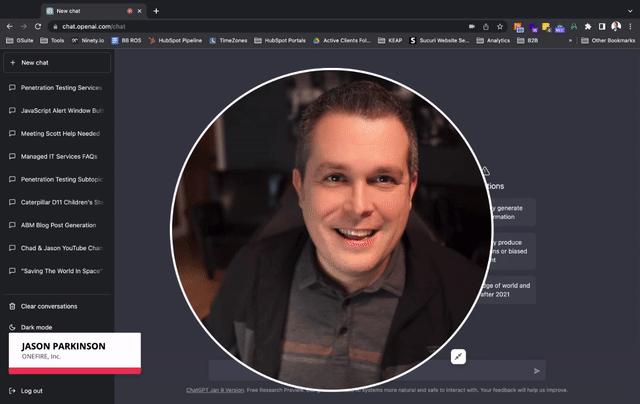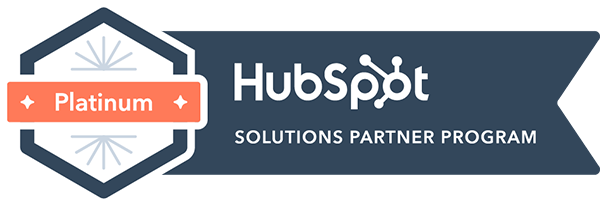 ChatGPT -- a large language generation model developed by OpenAI -- has been a headline fixture for the last few weeks. After some rigorous and highly-entertaining testing, we see why.
ChatGPT -- a large language generation model developed by OpenAI -- has been a headline fixture for the last few weeks. After some rigorous and highly-entertaining testing, we see why.
Artificial intelligence tools (like ChatGPT) can be incredibly useful and their copywriting potential is immense. We've heard from multiple MSPs that they plan to explore use cases for this technology and hope that it can provide a lot of quality blog content at scale.
Before we start digging into specific use cases or how effective they may or may not be, let's take a look at the pros and cons of using ChatGPT to create content for marketing, sales, and service.
First, if you haven’t seen ChatGPT in action, ONEFIRE’s Jason Parkinson shows you how it works and what it’s capable of:

Pros:
Save time:
One of the biggest advantages of using ChatGPT is the time it can save. Instead of spending hours writing and editing a single post, you can use ChatGPT to generate a high-quality and natural-sounding draft in a matter of minutes. This can free up time for other important tasks, such as researching, promoting, and analyzing your content.
It is blazing fast and for those who struggle to compose blogs from scratch, it feels like a minor miracle.
Save money:
ChatGPT can be a cost-effective solution for managed services providers that need to generate a large amount of content. Rather than hiring multiple writers or agencies, you can use ChatGPT to generate high-quality content at a fraction of the cost.
The version of ChatGPT available today is free, but that may not always be the case. Even so, using AI is likely going to remain more cost-effective than hiring a writer to produce blog content.
Consistency:
Using ChatGPT for writing blogs can provide a comforting consistency when contrasted with human writers. With its advanced natural language processing capabilities, ChatGPT can produce content that is highly consistent in terms of tone, style, and format. This can be especially useful for businesses that need to maintain a consistent brand voice across multiple platforms.
Hiring and replacing writing talent can lead to a mishmash of voices, perspectives, and styles.
Personalization:
ChatGPT can be fine-tuned to a specific industry or domain to generate highly relevant and personalized content. With this feature, you can be sure that your content is tailored to your target audience.
While it can't replace true expertise or experience in a complex topic like cybersecurity, ChatGPT can "learn" to use the language of your industry and personalize the copy it produces to your specific needs, based on the context and information you feed it.
Cons:
Quality control:
One of the most glaring downsides of using ChatGPT for writing blogs is the need for quality control. While ChatGPT can generate high-quality and natural-sounding content, it is not perfect and will require human editing to ensure that it is free of errors and meets the desired tone and style.
In our testing, we found that the tool is prone to repetitive copy, using identical or near-identical sentences across paragraphs.
This means that ChatGPT will need an editor and for MSPs, that likely means a seasoned SME to look over the copy to ensure that it's correct and written in a way that will resonate with ideal buyers.
Dependence on training data:
Another downside of using ChatGPT for writing blogs is that its performance is dependent on the quality of its training data. If the model is trained on low-quality or biased data, it may generate content that is not accurate or appropriate.
In a fast-paced space like IT and cybersecurity, ChatGPT may face limitations when asked to create copy about current events or technological advances, again due to training data context.
Lack of creativity:
AI, simply put, lacks creativity. While that may not be a deal-breaker for businesses looking to generate a huge library of blog resources, it is important to note that it's not capable of coming up with unique and original ideas.
Content produced by a human will always have a greater capacity to feel and sound more interesting, authentic, and provocative.
Understanding:
ChatGPT does not have the ability to truly understand the meaning behind the words it is generating. This means that it may not be able to fully grasp the nuances of a topic or provide unique insights.
Similar to the point above, AI can't have a perspective, so it can't provide the same level of insight as an expert in the topic can.
What does this mean for ChatGPT and your MSP?
ChatGPT is a powerful tool that can help you save time and cut costs, while delivering viable copy at scale. However, it is important to keep in mind that it is not a perfect solution and requires careful monitoring and editing to ensure that the final product is something you'll be confident posting under your brand. That said, the above cons are based on using this specific version of ChatGPT. As the technology continues to improve in the coming months and years, its limitations will be mitigated and the use cases will only grow stronger.
Interested in using ChatGPT in your MSP marketing, sales, or service efforts? Let's explore use cases together.




